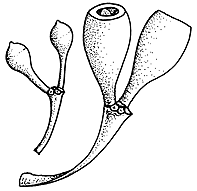Common name: Silvertop Ash, Black Ash
Eucalyptus sieberi L.A.S.Johnson APNI* Synonyms: Eucalyptus sieberiana F.Muell. APNI*

Description: Tree to 30 m high but sometimes to 45 m; bark persistent on trunk and larger branches, grey-brown to brown-black, shortly fibrous, compact, smooth above, grey or white, shedding in long ribbons; branchlets glaucous.
Juvenile leaves disjunct, broad-lanceolate to ovate, dull grey-green.
Adult leaves disjunct, lanceolate, 9–15 cm long, 1.2–2.8 cm wide, green, glossy, concolorous. Umbellasters 7–15-flowered; peduncle narrowly flattened or angular, 8–16 mm long; pedicels terete, 1–4 mm long. Buds clavate, 4–7 mm long, 3–4 mm diam., scar absent; calyptra hemispherical, shorter and as wide as hypanthium. Outer stamens infertile.
Fruit conical or pyriform, 8–11 mm long, 7–9 mm diam.; disc raised or flat (slightly); valves enclosed or rim-level. Locally dominant, in wet or dry sclerophyll forest or woodland on shallow soils of low to medium fertility on rises; south from Morisset district.
Distribution and occurrence:
NSW subdivisions: CC, SC, CT, ST, NC
Other Australian states: Vic. Tas.
Text by K. Hill
Taxon concept: Flora of NSW 2 (1991)
APNI* Provides a link to the Australian Plant Name Index (hosted by the Australian National Botanic Gardens) for comprehensive bibliographic data
***The AVH map option provides a detailed interactive Australia wide distribution map drawn from collections held by all major Australian herbaria participating in the Australian Virtual Herbarium project.
|


